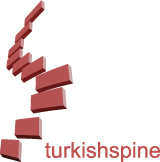ABSTRACT
Scheuermann’s disease is a spinal deformity that typically presents with back pain and cosmetic concerns. Neurological deficits are rare, particularly in adult patients without trauma or associated spinal pathology. We report the case of a 29-year-old female with a longstanding history of kyphosis, who presented with the onset of severe neurological deficits, including paraparesis and incontinence. Imaging revealed thoracic kyphosis with spinal cord compression at the apex without evidence of disc herniation or other spinal abnormalities. Surgical intervention using a posterior-only approach, including decompression and stabilization, was performed. Post-operative recovery was significant, with complete resolution of neurological symptoms at the one-year follow-up. This case underscores the importance of considering Scheuermann’s disease as a rare cause of severe neurological impairment. Advanced imaging modalities, such as diffusion tensor imaging, are valuable in detecting spinal cord involvement. Surgical decompression and kyphosis correction are critical for successful outcomes.
INTRODUCTION
Scheuermann’s disease, first described in 1921, is a form of dorsal kyphosis characterized by painful, rigid, and wedged vertebrae. It is commonly associated with vertebral endplate irregularities, Schmorl’s nodes, and narrowing of the intervertebral disc spaces(1, 2). This condition represents the most prevalent spinal deformity in adolescents after idiopathic scoliosis(3). While its exact etiology remains unclear, it is hypothesized to develop prior to puberty, following the ossification of the vertebral ring apophysis. The deformity typically becomes more pronounced during the adolescent growth spurt, most frequently between the ages of 12 and 15 years(4).
Scheuermann’s kyphosis rarely presents with significant clinical symptoms. The most common complaints include back pain and cosmetic concerns. The majority of cases are effectively managed through conservative measures or bracing. However, it is exceedingly uncommon for the condition to result in severe neurological deficits(5, 6). In this report, we present the case of an adult with Scheuermann’s kyphosis who experienced a sudden and severe neurological deficit. Notably, this case occurred in the absence of trauma, associated disc herniation, or other identifiable intraspinal pathology.
CASE PRESENTATION
A 29-year-old female presented with complaints of progressive back pain and gait disturbance, which had worsened over the past two years. She reported noticing a more pronounced kyphosis since her puberty, though she had not sought evaluation or treatment for it due to the absence of significant symptoms. Over the preceding three days, her symptoms had rapidly exacerbated, with marked numbness and paraparesis developing. She was unable to walk and denied any history of trauma.
On neurological examination, the patient exhibited 2/5 muscle strength in the lower extremities below the T7 level according to the Medical Research Council (MRC) scale. Spasticity in the bilateral lower extremities was graded as 2 using the Modified Ashworth Scale. Sensory testing revealed hypoesthesia below the T7 dermatome, with diminished light touch and pinprick sensation. Plantar reflexes were extensor bilaterally, while both knee and ankle reflexes were exaggerated. Bilateral clonus was noted. Superficial skin reflexes were absent. Additionally, the patient had urinary and fecal incontinence, accompanied by reduced tone of the external anal sphincter.
Investigations
Laboratory investigations, including markers for systemic inflammatory or autoimmune diseases, were unremarkable. Electromyography did not indicate any neuromuscular disease but revealed findings suggestive of active spinal cord compression.
Plain radiographs of the thoracic spine demonstrated anterior wedging of the vertebral bodies and kyphosis spanning the T6 to T8 levels (Figure 1). Thoracic kyphosis measured 55 degrees from T4 to T10. Flexion and extension lateral radiographs showed no change in the degree of hyperkyphosis, indicating a rigid deformity. Additional findings included endplate irregularities and narrowed disc spaces, consistent with the diagnosis of Scheuermann’s disease. Although features such as Schmorl’s nodes and endplate irregularities were not readily apparent on plain radiographs or magnetic resonance imaging (MRI), they were clearly visualized on computed tomography (CT) scans. CT provided detailed evidence of Scheuermann’s disease, showing anterior wedging, Schmorl’s nodes, degenerative disc changes, and narrowed disc spaces at the T6 to T8 levels. MRI, supplemented with diffusion tensor imaging (DTI), confirmed spinal cord compression at the apex of the kyphosis without evidence of disc herniation, tumor, or other spinal abnormalities (Figure 2). These findings, supported by the CT scans, align with the established diagnostic criteria for Scheuermann’s disease.
Management
Given the severity of the neurological deficit and radiological evidence of spinal cord compression, surgical intervention was planned. A posterior-only (PO) decompression and stabilization procedure was performed. Total laminectomies were conducted at the T6, T7, and T8 levels. Bilateral transpedicular screws were inserted from T5 to T10 for stabilization, and a rod system was used to correct the kyphosis. Intraoperative neuromonitoring confirmed spinal cord decompression without complications.
Post-operative imaging included a CT scan, which confirmed proper placement of the hardware and satisfactory correction of the kyphosis. Follow-up MRI with DTI demonstrated decompression of the spinal cord, with restored integrity of the compressed tracts (Figure 3).
Outcome and Follow-up
The patient experienced slight improvement in her motor deficit immediately post-operatively, with lower limb strength improving from 2/5 to 3/5 per the MRC scale. She was managed post-operatively with thoracolumbar rigid bracing and an intensive rehabilitation program. Initial therapy focused on passive range of motion exercises, progressing to postural training and assisted walking exercises.
One month post-operatively, the patient regained the ability to walk independently. At her one-year follow-up, she demonstrated complete neurological recovery, including restored motor strength, resolution of spasticity, and regained sphincter control. Radiographic follow-up confirmed stable instrumentation and maintained correction of the kyphosis. Written informed consent was obtained from the patient for the publication of this case report and any accompanying images.
DISCUSSION
The dura mater is fixed at the skull and sacrum, allowing limited elasticity along the spinal column. As the spine flexes and extends, the spinal cord experiences stretching and relaxation. Notably, the thoracic spine-especially the upper thoracic region-exhibits the least elasticity, rendering it more vulnerable to deformities, particularly acquired ones. Thoracic kyphosis stretches the posterior dura excessively, potentially leading to spinal cord compression(7, 8).
Most deformities progress gradually, allowing the dura and spinal cord to adapt without causing neurological symptoms. However, severe neurological deficits, as seen in our case, have been reported in the literature. In this case, CT scans were crucial in identifying the diagnostic features of Scheuermann’s disease, including anterior wedging, Schmorl’s nodes, and endplate irregularities, which were less evident on plain radiographs and MRI. These findings, combined with the kyphosis angle of 55 degrees, fulfilled the diagnostic criteria for Scheuermann’s disease. The thoracic kyphosis and spinal cord compression occurring at the apex of the deformity further underscore the significance of this rare presentation. These cases typically involve younger patients in their second decade of life during growth spurts, often associated with trauma or concomitant disc herniation(9-12). While the prevalence of Scheuermann’s disease is similar among males and females, males are more prone to developing spinal cord compression due to more pronounced spinal growth and a greater contribution of trunk growth during adolescence(13, 14). Our case is unique because it involves a 29-year-old female without a history of trauma or associated spinal pathology, highlighting the atypical presentation in adulthood.
Factors Influencing Neurological Complications
Several parameters influence the progression of deformities leading to neurological deficits. These include the kyphosis angle, the number of segments involved, the rate of deformity progression, local anatomical variations, concomitant disc herniation, hypertrophy of the facet joints or ligamentum flavum, and vascular compromise of the spinal cord(13, 15). A study reported the average kyphosis angle in Scheuermann’s disease as 56.3 degrees and found no significant correlation between kyphosis angle and neurological complications. Contrarily, another study indicated that higher kyphosis angles correlated with an increased risk of neurological impairment, regardless of the deformity’s underlying cause. Interestingly, this study also suggested that neurological impairment is less likely when larger segments of the spine are involved(14).
Disc herniation is a frequent finding at the deformity’s apex, often at T7-T8 or T8-T9 levels. Due to the stretched spinal cord, even a minor disc protrusion can result in significant neurological impairment. In younger patients, the harder nature of non-degenerated disc material exacerbates the compression. However, the presence of Schmorl’s nodes may act as a protective mechanism by redirecting disc material toward the vertebral body instead of the spinal canal(10, 12, 16).
Surgical Management
Early surgical intervention is crucial in cases presenting with neurological deficits. The primary objectives of surgery are spinal cord decompression and deformity correction (4, 17). A combined anterior-posterior (AP) approach is traditionally recommended due to the frequent presence of disc herniation at the deformity’s apex, which often contributes to compression. However, recent meta-analyses comparing AP and PO approaches found no significant differences in kyphosis correction, proximal junctional kyphosis, or distal junctional kyphosis. Furthermore, the PO approach was associated with reduced blood loss and shorter surgical duration(18, 19).
In our case, the absence of disc protrusion allowed successful decompression and kyphosis correction through a PO approach. Post-operative recovery was favorable, with the patient achieving full neurological recovery within a year. These findings suggest that PO surgery can be an effective option for Scheuermann’s disease cases without significant disc pathology.
CONCLUSION
Scheuermann’s disease is an uncommon cause of neurological impairment, with spinal cord compression occurring only in rare cases. Advanced imaging modalities, such as spinal MRI with DTI, play a pivotal role in identifying the underlying pathology and determining the extent of spinal cord involvement. Early detection and prompt surgical intervention are critical for achieving optimal outcomes. Surgical treatment focusing on spinal cord decompression and kyphosis correction offers an effective solution, particularly in cases presenting with severe neurological deficits.



